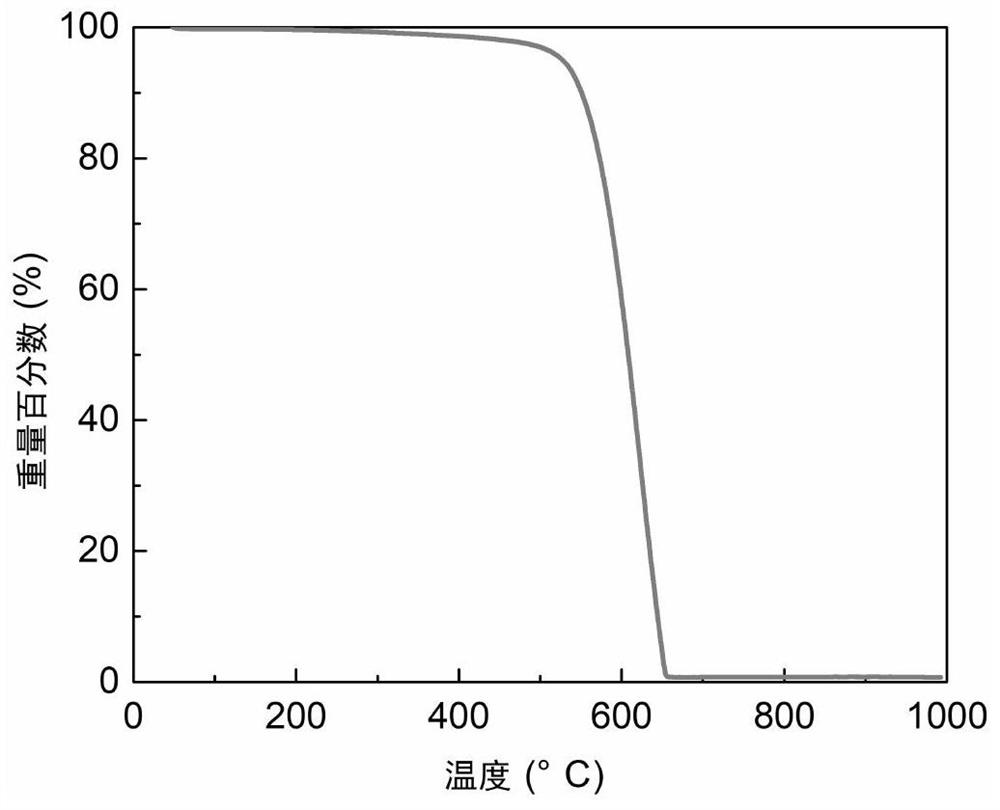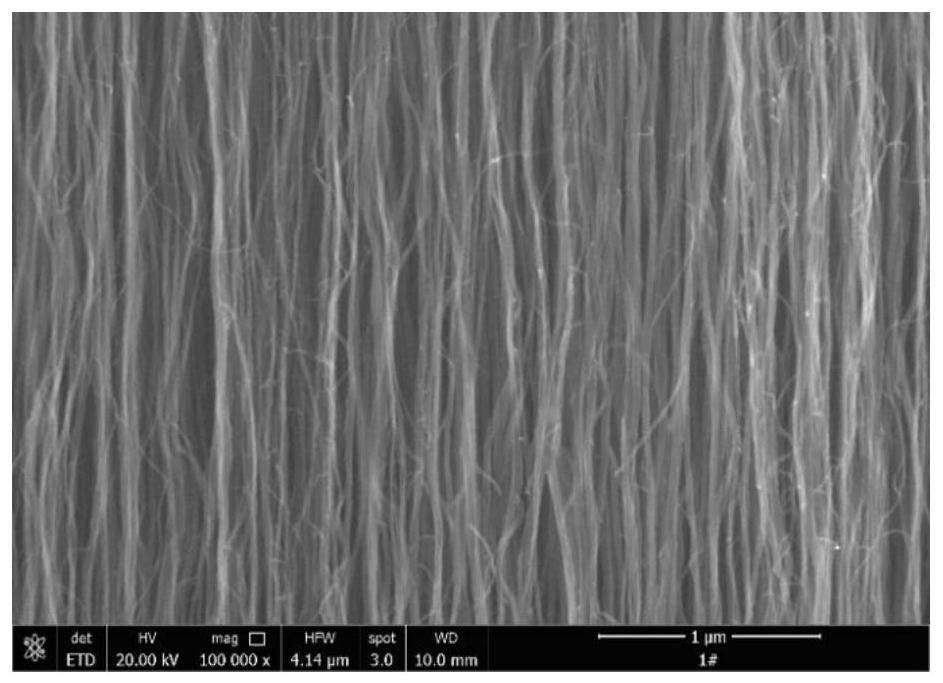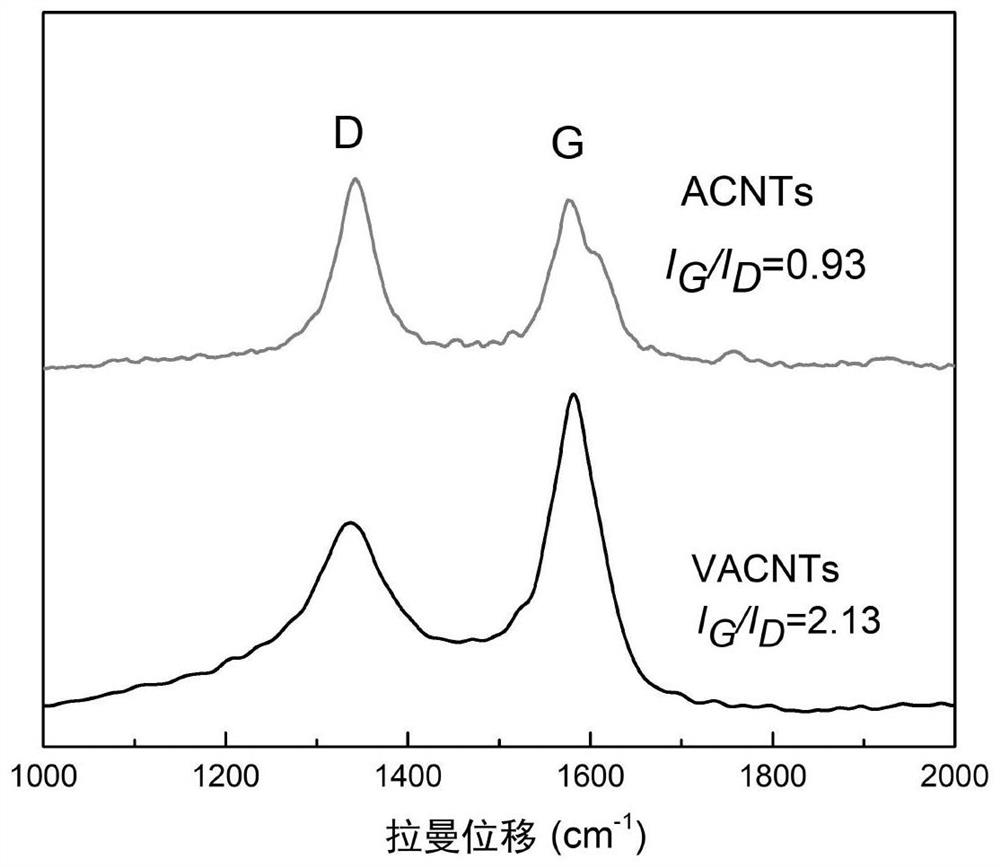Preparation method of winding-free carbon nanotube for lithium ion battery
A technology of lithium-ion batteries and carbon nanotubes, applied in the direction of carbon nanotubes, nanocarbons, secondary batteries, etc., can solve the problems of low purity, poor conductivity, carbon tube winding, etc., and achieve the effect of high purity
- Summary
- Abstract
- Description
- Claims
- Application Information
AI Technical Summary
Problems solved by technology
Method used
Image
Examples
Embodiment 1
[0047] Step (1): Select a silicon wafer polished on one side as a substrate, and clean it with ultrasonic vibration in deionized water, acetone and isopropanone in sequence before use. This is for immediate application without chemical cleaning or surface polishing.
[0048] Step (2): At room temperature, aluminum oxide is used as a target material, the radio frequency power is set to 150 W, the sputtering pressure is 11 sccm and the reaction is performed for 5 minutes to obtain a 25 nm thick aluminum oxide film by sputtering.
[0049] Step (3): After reactive magnetron sputtering alumina, iron / yttrium alloy was used as the target (the ratio of iron and yttrium was 95:5), at 25°C, the DC sputtering power was set to 100W, and the sputtering The air pressure was 12 sccm and the reaction was carried out for 5 minutes to obtain a catalyst iron yttrium thin film with a thickness of 30 nm.
[0050] Step (4): Put the prepared catalyst precursor into a tube furnace, feed in 500 sccm ...
Embodiment 2
[0055] Step (1) select a silicon wafer polished on one side as a substrate, and clean it with ultrasonic vibration in deionized water, acetone and isopropanone in sequence before use. This is for immediate application without chemical cleaning or surface polishing.
[0056] Step (2) At room temperature, silicon oxide is used as a target material, the radio frequency power is set to 150W, the sputtering pressure is 11 sccm and the reaction is performed for 5 minutes to obtain a silicon oxide film with a thickness of 35nm by sputtering.
[0057] Step (3) After reactive magnetron sputtering of silicon oxide, use manganese / yttrium alloy as the target (the ratio of manganese to yttrium is 95:5), set the DC sputtering power to 60W at 25°C, and the sputtering pressure to 12 sccm and react for 1 min to obtain a catalyst manganese / yttrium thin film with a thickness of 10 nm.
[0058] Step (4) Put the prepared catalyst precursor into a tube furnace, feed in 500 sccm of argon as a prote...
Embodiment 3
[0064] Step (1): Select a silicon wafer polished on one side as a substrate, and clean it with ultrasonic vibration in deionized water, acetone and isopropanone in sequence before use. This is for immediate application without chemical cleaning or surface polishing.
[0065] Step (2): At room temperature, aluminum oxide is used as a target material, the radio frequency power is set to 150 W, the sputtering pressure is 11 sccm and the reaction is performed for 5 minutes to obtain a 25 nm thick aluminum oxide film by sputtering.
[0066] Step (3): After reactive magnetron sputtering alumina, iron / yttrium / lutetium alloy is used as the target (the ratio of iron, yttrium, and lutetium is 95:2:3), and DC sputtering is set at 25°C The power is 80W, the sputtering pressure is 12sccm and the reaction is carried out for 3 minutes to obtain a catalyst iron / yttrium / lutetium thin film with a thickness of 15nm.
[0067] Step (4): Put the prepared catalyst precursor into a tube furnace, fee...
PUM
| Property | Measurement | Unit |
|---|---|---|
| diameter | aaaaa | aaaaa |
Abstract
Description
Claims
Application Information
 Login to View More
Login to View More - R&D
- Intellectual Property
- Life Sciences
- Materials
- Tech Scout
- Unparalleled Data Quality
- Higher Quality Content
- 60% Fewer Hallucinations
Browse by: Latest US Patents, China's latest patents, Technical Efficacy Thesaurus, Application Domain, Technology Topic, Popular Technical Reports.
© 2025 PatSnap. All rights reserved.Legal|Privacy policy|Modern Slavery Act Transparency Statement|Sitemap|About US| Contact US: help@patsnap.com



